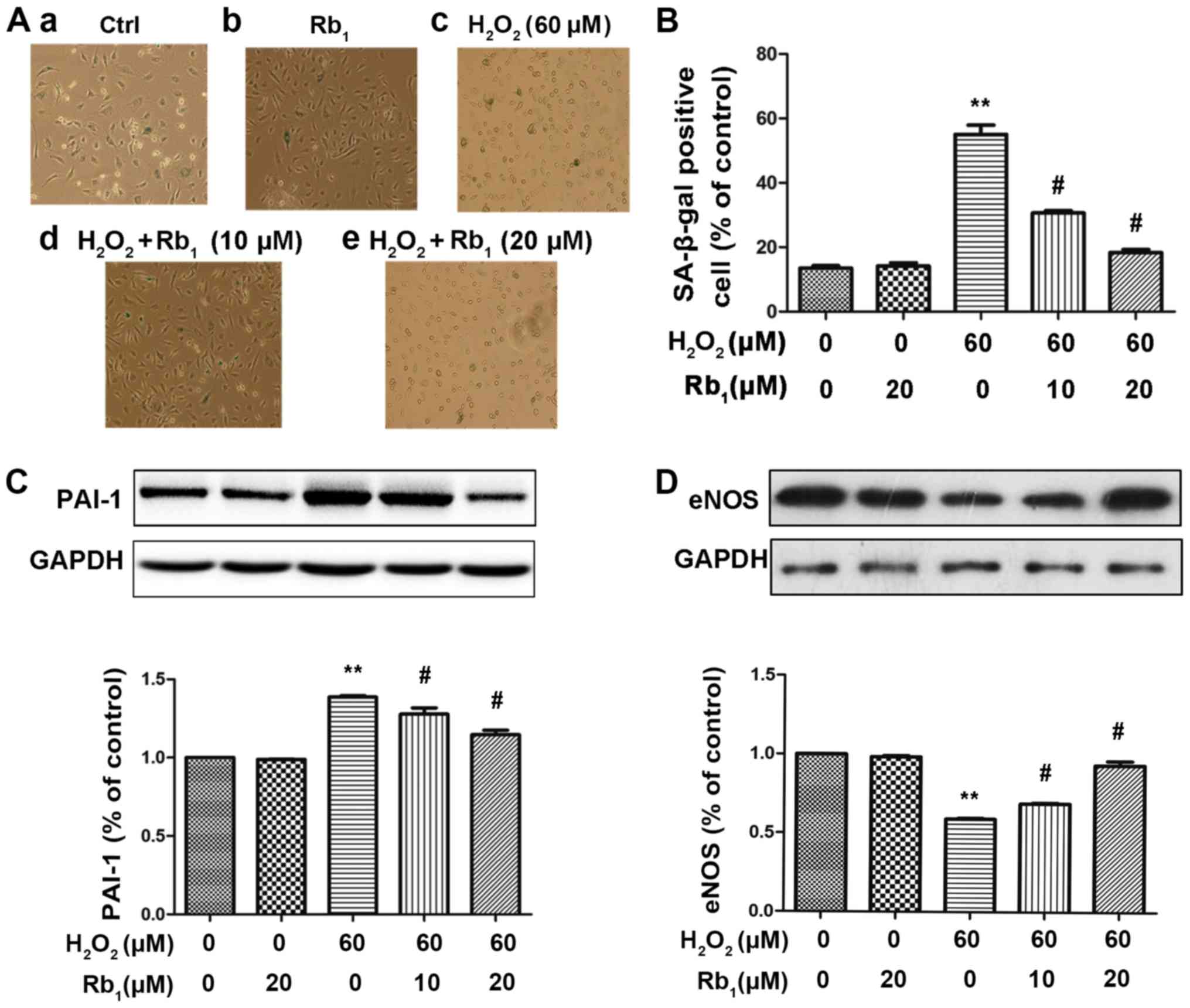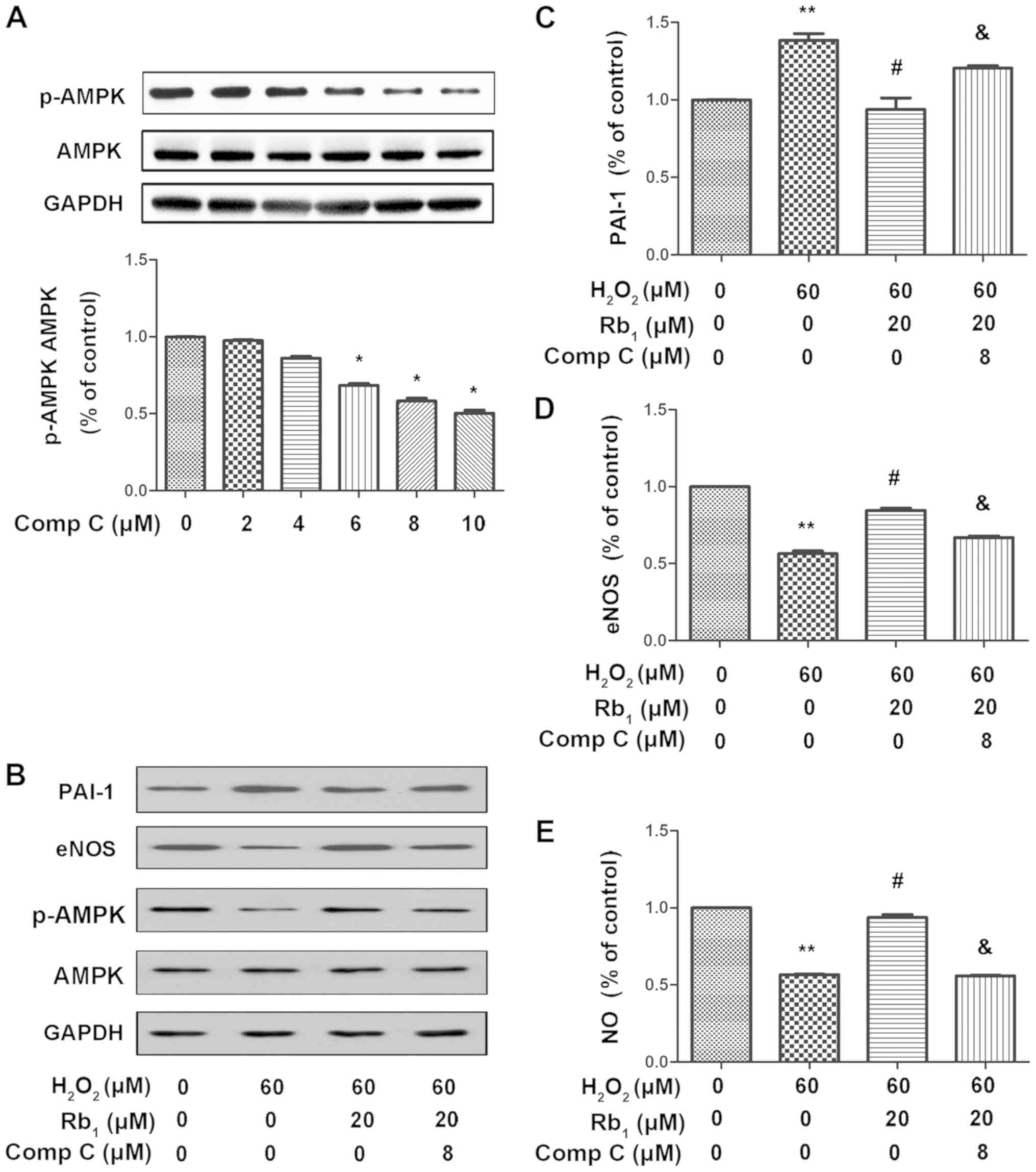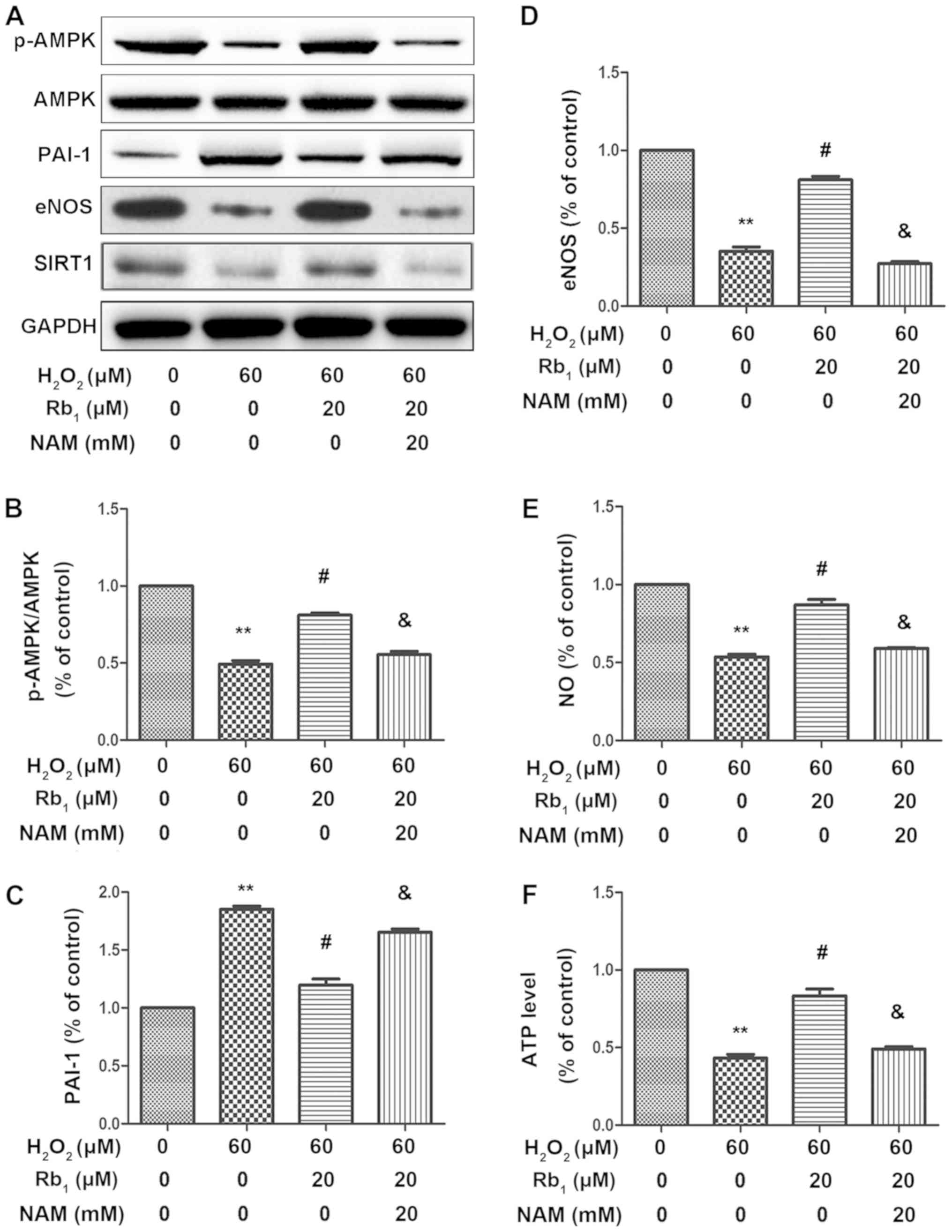|
1
|
Quyyumi AA: Endothelial function in health
and disease: New insights into the genesis of cardiovascular
disease. Am J Med. 105:32S–39S. 1998. View Article : Google Scholar : PubMed/NCBI
|
|
2
|
Minamino T, Miyauchi H, Yoshida T, Ishida
Y, Yoshida H and Komuro I: Endothelial cell senescence in human
atherosclerosis: Role of telomere in endothelial dysfunction.
Circulation. 105:1541–1544. 2002. View Article : Google Scholar : PubMed/NCBI
|
|
3
|
Barton M: Obesity and aging: Determinants
of endothelial cell dysfunction and atherosclerosis. Pflugers Arch.
460:825–837. 2010. View Article : Google Scholar : PubMed/NCBI
|
|
4
|
Ota H, Eto M, Kano MR, Kahyo T, Setou M,
Ogawa S, Iijima K, Akishita M and Ouchi Y: Induction of endothelial
nitric oxide synthase, SIRT1, and catalase by statins inhibits
endothelial senescence through the Akt pathway. Arterioscler Thromb
Vasc Biol. 30:2205–2211. 2010. View Article : Google Scholar : PubMed/NCBI
|
|
5
|
Ruan Y, Wu S, Zhang L, Chen G and Lai W:
Retarding the senescence of human vascular endothelial cells
induced by hydrogen peroxide: Effects of 17beta-estradiol (E2)
mediated mitochondria protection. Biogerontology. 15:367–375. 2014.
View Article : Google Scholar : PubMed/NCBI
|
|
6
|
Cai H: Hydrogen peroxide regulation of
endothelial function: Origins, mechanisms, and consequences.
Cardiovasc Res. 68:26–36. 2005. View Article : Google Scholar : PubMed/NCBI
|
|
7
|
Han X, Tai H, Wang X, Wang Z, Zhou J, Wei
X, Ding Y, Gong H, Mo C, Zhang J, et al: AMPK activation protects
cells from oxidative stress-induced senescence via autophagic flux
restoration and intracellular NAD(+) elevation. Aging Cell.
15:416–427. 2016. View Article : Google Scholar : PubMed/NCBI
|
|
8
|
Conti V, Corbi G, Simeon V, Russomanno G,
Manzo V, Ferrara N and Filippelli A: Aging-related changes in
oxidative stress response of human endothelial cells. Aging Clin
Exp Res. 27:547–553. 2015. View Article : Google Scholar : PubMed/NCBI
|
|
9
|
El Assar M, Angulo J and Rodriguez-Manas
L: Oxidative stress and vascular inflammation in aging. Free Radic
Biol Med. 65:380–401. 2013. View Article : Google Scholar : PubMed/NCBI
|
|
10
|
Sindler AL, Delp MD, Reyes R, Wu G and
Muller-Delp JM: Effects of ageing and exercise training on eNOS
uncoupling in skeletal muscle resistance arterioles. J Physiol.
587:3885–3897. 2009. View Article : Google Scholar : PubMed/NCBI
|
|
11
|
Kang LS, Reyes RA and Muller-Delp JM:
Aging impairs flow-induced dilation in coronary arterioles: Role of
NO and H(2)O(2). Am J Physiol Heart Circ Physiol. 297:H1087–H1095.
2009. View Article : Google Scholar : PubMed/NCBI
|
|
12
|
Xiong Y, Shen L, Liu KJ, Tso P, Xiong Y,
Wang G, Woods SC and Liu M: Antiobesity and antihyperglycemic
effects of ginsenoside Rb1 in rats. Diabetes. 59:2505–2512. 2010.
View Article : Google Scholar : PubMed/NCBI
|
|
13
|
Chen S, Li X, Wang Y, Mu P, Chen C, Huang
P and Liu D: Ginsenoside Rb1 attenuates intestinal
ischemia/reperfusion-induced inflammation and oxidative stress via
activation of the PI3K/Akt/Nrf2 signaling pathway. Mol Med Rep.
19:3633–3641. 2019.PubMed/NCBI
|
|
14
|
Sun Q, Meng QT, Jiang Y, Liu HM, Lei SQ,
Su WT, Duan WN, Wu Y and Xia ZY and Xia ZY: Protective effect of
ginsenoside Rb1 against intestinal ischemia-reperfusion induced
acute renal injury in mice. PLoS One. 8:e808592013. View Article : Google Scholar : PubMed/NCBI
|
|
15
|
Wang M, Chen Y, Xiong Z, Yu S, Zhou B,
Ling Y, Zheng Z, Shi G, Wu Y and Qian X: Ginsenoside Rb1 inhibits
free fatty acidsinduced oxidative stress and inflammation in 3T3-L1
adipocytes. Mol Med Rep. 16:9165–9172. 2017. View Article : Google Scholar : PubMed/NCBI
|
|
16
|
Liu DH, Chen YM, Liu Y, Hao BS, Zhou B, Wu
L, Wang M, Chen L, Wu WK and Qian XX: Rb1 protects endothelial
cells from hydrogen peroxide-induced cell senescence by modulating
redox status. Biol Pharm Bull. 34:1072–1077. 2011. View Article : Google Scholar : PubMed/NCBI
|
|
17
|
Herzig S and Shaw RJ: AMPK: Guardian of
metabolism and mitochondrial homeostasis. Nat Rev Mol Cell Biol.
19:121–135. 2018. View Article : Google Scholar : PubMed/NCBI
|
|
18
|
Zhang M, Wang S, Pan Z, Ou T, Ma J, Liu H,
Li R, Yang P, Han W, Guan S, et al: AMPK/NF-KB signaling pathway
regulated by ghrelin participates in the regulation of HUVEC and
THP1 Inflammation. Mol Cell Biochem. 437:45–53. 2018. View Article : Google Scholar : PubMed/NCBI
|
|
19
|
Thornton CC, Al-Rashed F, Calay D, Birdsey
GM, Bauer A, Mylroie H, Morley BJ, Randi AM, Haskard DO, Boyle JJ
and Mason JC: Methotrexate-mediated activation of an
AMPK-CREB-dependent pathway: A novel mechanism for vascular
protection in chronic systemic inflammation. Ann Rheum Dis.
75:439–448. 2016. View Article : Google Scholar : PubMed/NCBI
|
|
20
|
Martinez-Martin N, Blas-Garcia A, Morales
JM, Marti-Cabrera M, Monleon D and Apostolova N: Metabolomics of
the effect of AMPK activation by AICAR on human umbilical vein
endothelial cells. Int J Mol Med. 29:88–94. 2012.PubMed/NCBI
|
|
21
|
Huang NL, Chiang SH, Hsueh CH, Liang YJ,
Chen YJ and Lai LP: Metformin inhibits TNF-alpha-induced IkappaB
kinase phosphorylation, IkappaB-alpha degradation and IL-6
production in endothelial cells through PI3K-dependent AMPK
phosphorylation. Int J Cardiol. 134:169–175. 2009. View Article : Google Scholar : PubMed/NCBI
|
|
22
|
Nagata D, Mogi M and Walsh K:
AMP-activated protein kinase (AMPK) signaling in endothelial cells
is essential for angiogenesis in response to hypoxic stress. J Biol
Chem. 278:31000–31006. 2003. View Article : Google Scholar : PubMed/NCBI
|
|
23
|
Ido Y, Carling D and Ruderman N:
Hyperglycemia-induced apoptosis in human umbilical vein endothelial
cells: Inhibition by the AMP-activated protein kinase activation.
Diabetes. 51:159–167. 2002. View Article : Google Scholar : PubMed/NCBI
|
|
24
|
Zhou H, Fu B, Xu B, Mi X, Li G, Ma C, Xie
J, Li J and Wang Z: Rosmarinic acid alleviates the endothelial
dysfunction induced by hydrogen peroxide in rat aortic rings via
activation of AMPK. Oxid Med Cell Longev. 2017:70919042017.
View Article : Google Scholar : PubMed/NCBI
|
|
25
|
Zaborska KE, Edwards G, Austin C and
Wareing M: The role of O-GlcNAcylation in perivascular adipose
tissue dysfunction of offspring of high-fat diet-fed rats. J Vasc
Res. 54:79–91. 2017. View Article : Google Scholar : PubMed/NCBI
|
|
26
|
Baudin B, Bruneel A, Bosselut N and
Vaubourdolle M: A protocol for isolation and culture of human
umbilical vein endothelial cells. Nat Protoc. 2:481–485. 2007.
View Article : Google Scholar : PubMed/NCBI
|
|
27
|
Guo Y, Xing L, Qian C, Ding Z and Jin B:
Involvement of flavonoids from the leaves of carya cathayensis
sarg. In sirtuin 1 expression in HUVEC senescence. Evid Based
Complement Alternat Med. 2018:82465602018. View Article : Google Scholar : PubMed/NCBI
|
|
28
|
Esfahanian N, Shakiba Y, Nikbin B, Soraya
H, Maleki-Dizaji N, Ghazi-Khansari M and Garjani A: Effect of
metformin on the proliferation, migration, and MMP-2 and −9
expression of human umbilical vein endothelial cells. Mol Med Rep.
5:1068–1074. 2012. View Article : Google Scholar : PubMed/NCBI
|
|
29
|
Zheng S, Li W, Xu M, Bai X, Zhou Z, Han J,
Shyy JY and Wang X: Calcitonin gene-related peptide promotes
angiogenesis via AMP-activated protein kinase. Am J Physiol Cell
Physiol. 299:C1485–C1492. 2010. View Article : Google Scholar : PubMed/NCBI
|
|
30
|
Green LC, Wagner DA, Glogowski J, Skipper
PL, Wishnok JS and Tannenbaum SR: Analysis of nitrate, nitrite, and
[15N]nitrate in biological fluids. Anal Biochem. 126:131–138. 1982.
View Article : Google Scholar : PubMed/NCBI
|
|
31
|
Debacq-Chainiaux F, Erusalimsky JD,
Campisi J and Toussaint O: Protocols to detect
senescence-associated beta-galactosidase (SA-betagal) activity, a
biomarker of senescent cells in culture and in vivo. Nat Protoc.
4:1798–1806. 2009. View Article : Google Scholar : PubMed/NCBI
|
|
32
|
Luo W, Wang Y, Yang H, Dai C, Hong H, Li
J, Liu Z, Guo Z, Chen X, He P, et al: Heme oxygenase-1 ameliorates
oxidative stress-induced endothelial senescence via regulating
endothelial nitric oxide synthase activation and coupling. Aging
(Albany NY). 10:1722–1744. 2018. View Article : Google Scholar : PubMed/NCBI
|
|
33
|
Yan J, Wang J, Huang H, Huang Y, Mi T,
Zhang C and Zhang L: Fibroblast growth factor 21 delayed
endothelial replicative senescence and protected cells from
H2O2-induced premature senescence through
SIRT1. Am J Transl Res. 9:4492–4501. 2017.PubMed/NCBI
|
|
34
|
Lin XL, Liu Y, Liu M, Hu H, Pan Y, Fan XJ,
Hu XM and Zou WW: Inhibition of hydrogen peroxide-induced human
umbilical vein endothelial cells aging by allicin depends on
sirtuin1 activation. Med Sci Monit. 23:563–570. 2017. View Article : Google Scholar : PubMed/NCBI
|
|
35
|
Hahn HJ, Kim KB, An IS, Ahn KJ and Han HJ:
Protective effects of rosmarinic acid against hydrogen
peroxide-induced cellular senescence and the inflammatory response
in normal human dermal fibroblasts. Mol Med Rep. 16:9763–9769.
2017. View Article : Google Scholar : PubMed/NCBI
|
|
36
|
Song Z, Liu Y, Hao B, Yu S, Zhang H, Liu
D, Zhou B, Wu L, Wang M, Xiong Z, et al: Ginsenoside Rb1 prevents
H2O2-induced HUVEC senescence by stimulating sirtuin-1 pathway.
PLoS One. 9:e1126992014. View Article : Google Scholar : PubMed/NCBI
|
|
37
|
Liu DH, Chen YM, Liu Y, Hao BS, Zhou B, Wu
L, Wang M, Chen L, Wu WK and Qian XX: Ginsenoside Rb1 reverses
H2O2-induced senescence in human umbilical endothelial cells:
Involvement of eNOS pathway. J Cardiovasc Pharmacol. 59:222–230.
2012. View Article : Google Scholar : PubMed/NCBI
|
|
38
|
Erusalimsky JD and Kurz DJ: Cellular
senescence in vivo: Its relevance in ageing and cardiovascular
disease. Exp Gerontol. 40:634–642. 2005. View Article : Google Scholar : PubMed/NCBI
|
|
39
|
Shan HY, Bai XJ and Chen XM: Apoptosis is
involved in the senescence of endothelial cells induced by
angiotensin II. Cell Biol Int. 32:264–270. 2008. View Article : Google Scholar : PubMed/NCBI
|
|
40
|
Li CX, Gao JG, Wan XY, Chen Y, Xu CF, Feng
ZM, Zeng H, Lin YM, Ma H, Xu P, et al: Allyl isothiocyanate
ameliorates lipid accumulation and inflammation in nonalcoholic
fatty liver disease via the Sirt1/AMPK and NF-KB signaling
pathways. World J Gastroenterol. 25:5120–5133. 2019. View Article : Google Scholar : PubMed/NCBI
|
|
41
|
Wang T, Gu J, Wu PF, Wang F, Xiong Z, Yang
YJ, Wu WN, Dong LD and Chen JG: Protection by tetrahydroxystilbene
glucoside against cerebral ischemia: Involvement of JNK, SIRT1, and
NF-kappaB pathways and inhibition of intracellular ROS/RNS
generation. Free Radic Biol Med. 47:229–240. 2009. View Article : Google Scholar : PubMed/NCBI
|
|
42
|
Lee JH, Song MY, Song EK, Kim EK, Moon WS,
Han MK, Park JW, Kwon KB and Park BH: Overexpression of SIRT1
protects pancreatic beta-cells against cytokine toxicity by
suppressing the nuclear factor-kappaB signaling pathway. Diabetes.
58:344–351. 2009. View Article : Google Scholar : PubMed/NCBI
|
|
43
|
Huang K, Li R and Wei W: Sirt1 activation
prevents anti-Thy 1.1 mesangial proliferative glomerulonephritis in
the rat through the Nrf2/ARE pathway. Eur J Pharmacol. 832:138–144.
2018. View Article : Google Scholar : PubMed/NCBI
|
|
44
|
Huang K, Chen C, Hao J, Huang J, Wang S,
Liu P and Huang H: Polydatin promotes Nrf2-ARE anti-oxidative
pathway through activating Sirt1 to resist AGEs-induced
upregulation of fibronetin and transforming growth factor-β1 in rat
glomerular messangial cells. Mol Cell Endocrinol. 399:178–189.
2015. View Article : Google Scholar : PubMed/NCBI
|
|
45
|
Chen AF, Chen DD, Daiber A, Faraci FM, Li
H, Rembold CM and Laher I: Free radical biology of the
cardiovascular system. Clin Sci (Lond). 123:73–91. 2012. View Article : Google Scholar : PubMed/NCBI
|
|
46
|
Zhou P, Lu S, Luo Y, Wang S, Yang K, Zhai
Y, Sun G and Sun X: Attenuation of TNF-α-induced inflammatory
injury in endothelial cells by ginsenoside Rb1 via inhibiting
NF-KB, JNK and p38 signaling pathways. Front Pharmacol. 8:4642017.
View Article : Google Scholar : PubMed/NCBI
|
|
47
|
Yuan Q, Jiang YW, Ma TT, Fang QH and Pan
L: Attenuating effect of Ginsenoside Rb1 on LPS-induced lung injury
in rats. J Inflamm (Lond). 11:402014. View Article : Google Scholar : PubMed/NCBI
|
|
48
|
Hwang HJ, Jung TW, Kim JW, Kim JA, Lee YB,
Hong SH, Roh E, Choi KM, Baik SH and Yoo HJ: Protectin DX prevents
H2O2-mediated oxidative stress in vascular
endothelial cells via an AMPK-dependent mechanism. Cell Signal.
53:14–21. 2019. View Article : Google Scholar : PubMed/NCBI
|
|
49
|
Wang L, Han J, Shan P, You S, Chen X, Jin
Y, Wang J, Huang W, Wang Y and Liang G: MD2 blockage protects
obesity-induced vascular remodeling via activating AMPK/Nrf2.
obesity (Silver Spring). 25:1532–1539. 2017. View Article : Google Scholar : PubMed/NCBI
|
|
50
|
Lu Q, Mundy M, Chambers E, Lange T, Newton
J, Borgas D, Yao H, Choudhary G, Basak R, Oldham M and Rounds S:
Alda-1 protects against acrolein-induced acute lung injury and
endothelial barrier dysfunction. Am J Respir Cell Mol Biol.
57:662–673. 2017. View Article : Google Scholar : PubMed/NCBI
|
|
51
|
Kroller-Schon S, Jansen T, Hauptmann F,
Schüler A, Heeren T, Hausding M, Oelze M, Viollet B, Keaney JF Jr,
Wenzel P, et al: α1AMP-activated protein kinase mediates vascular
protective effects of exercise. Arterioscler Thromb Vasc Biol.
32:1632–1641. 2012. View Article : Google Scholar : PubMed/NCBI
|
|
52
|
Morrow VA, Foufelle F, Connell JM, Petrie
JR, Gould GW and Salt IP: Direct activation of AMP-activated
protein kinase stimulates nitric-oxide synthesis in human aortic
endothelial cells. J Biol Chem. 278:31629–31639. 2003. View Article : Google Scholar : PubMed/NCBI
|
|
53
|
Gaskin FS, Kamada K, Yusof M and Korthuis
RJ: 5′-AMP-activated protein kinase activation prevents
postischemic leukocyte-endothelial cell adhesive interactions. Am J
Physiol Heart Circ Physiol. 292:H326–H332. 2007. View Article : Google Scholar : PubMed/NCBI
|
|
54
|
Han F, Zhang S, Hou N, Wang D and Sun X:
Irisin improves endothelial function in obese mice through the
AMPK-eNOS pathway. Am J Physiol Heart Circ Physiol.
309:H1501–H1508. 2015. View Article : Google Scholar : PubMed/NCBI
|
|
55
|
Winnik S, Auwerx J, Sinclair DA and Matter
CM: Protective effects of sirtuins in cardiovascular diseases: From
bench to bedside. Eur Heart J. 36:3404–3412. 2015. View Article : Google Scholar : PubMed/NCBI
|
|
56
|
Stein S and Matter CM: Protective roles of
SIRT1 in atherosclerosis. Cell Cycle. 10:640–647. 2011. View Article : Google Scholar : PubMed/NCBI
|
|
57
|
Imai S, Armstrong CM, Kaeberlein M and
Guarente L: Transcriptional silencing and longevity protein Sir2 is
an NAD-dependent histone deacetylase. Nature. 403:795–800. 2000.
View Article : Google Scholar : PubMed/NCBI
|
|
58
|
Yuan Q, Zhang D, Liu C, Zhang C and Yuan
D: Chikusetsusaponin V inhibits LPS-activated inflammatory
responses via SIRT1/NF-KB signaling pathway in RAW264.7 cells.
Inflammation. 41:2149–2159. 2018. View Article : Google Scholar : PubMed/NCBI
|
|
59
|
Qian Y, Chen C, Ma L, Wang Z, Wang LF, Zuo
L, Yang Y, Huang X, Jiang M, Wang X, et al: CD38 deficiency
promotes inflammatory response through activating
Sirt1/NF-κB-mediated inhibition of TLR2 expression in macrophages.
Mediators Inflamm. 2018:87369492018. View Article : Google Scholar : PubMed/NCBI
|
|
60
|
Li M, Hong W, Hao C, Li L, Wu D, Shen A,
Lu J, Zheng Y, Li P and Xu Y: SIRT1 antagonizes liver fibrosis by
blocking hepatic stellate cell activation in mice. FASEB J.
32:500–511. 2018. View Article : Google Scholar : PubMed/NCBI
|
|
61
|
Kao CL, Chen LK, Chang YL, Yung MC, Hsu
CC, Chen YC, Lo WL, Chen SJ, Ku HH and Hwang SJ: Resveratrol
protects human endothelium from H(2)O(2)-induced oxidative stress
and senescence via SirT1 activation. J Atheroscler Thromb.
17:970–979. 2010. View Article : Google Scholar : PubMed/NCBI
|
|
62
|
Ota H, Akishita M, Eto M, Iijima K, Kaneki
M and Ouchi Y: Sirt1 modulates premature senescence-like phenotype
in human endothelial cells. J Mol Cell Cardiol. 43:571–579. 2007.
View Article : Google Scholar : PubMed/NCBI
|
|
63
|
Ota H, Eto M, Kano MR, Ogawa S, Iijima K,
Akishita M and Ouchi Y: Cilostazol inhibits oxidative
stress-induced premature senescence via upregulation of Sirt1 in
human endothelial cells. Arterioscler Thromb Vasc Biol.
28:1634–1639. 2008. View Article : Google Scholar : PubMed/NCBI
|
|
64
|
Cacicedo JM, Gauthier MS, Lebrasseur NK,
Jasuja R, Ruderman NB and Ido Y: Acute exercise activates AMPK and
eNOS in the mouse aorta. Am J Physiol Heart Circ Physiol.
301:H1255–H1265. 2011. View Article : Google Scholar : PubMed/NCBI
|
|
65
|
Gao D, Zuo Z, Tian J, Ali Q, Lin Y, Lei H
and Sun Z: Activation of SIRT1 attenuates klotho deficiency-induced
arterial stiffness and hypertension by enhancing AMP-activated
protein kinase activity. Hypertension. 68:1191–1199. 2016.
View Article : Google Scholar : PubMed/NCBI
|
|
66
|
Canto C, Gerhart-Hines Z, Feige JN,
Lagouge M, Noriega L, Milne JC, Elliott PJ, Puigserver P and Auwerx
J: AMPK regulates energy expenditure by modulating NAD+ metabolism
and SIRT1 activity. Nature. 458:1056–1060. 2009. View Article : Google Scholar : PubMed/NCBI
|
|
67
|
Chau MD, Gao J, Yang Q, Wu Z and Gromada
J: Fibroblast growth factor 21 regulates energy metabolism by
activating the AMPK-SIRT1-PGC-1alpha pathway. Proc Natl Acad Sci
USA. 107:12553–12558. 2010. View Article : Google Scholar : PubMed/NCBI
|


















